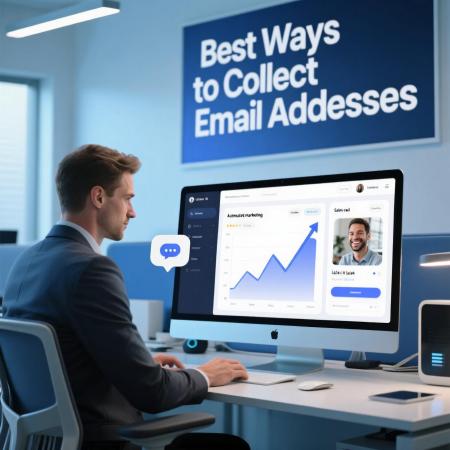Offering Something Valuable in Return
People are more likely to give you their email address if you offer them something good in return. This is called a "lead magnet." A lead magnet is something valuable that you give away for free in exchange for an email address. For example, if you sell e-books, you could offer a free chapter. If you have a website about cooking, you could offer a free recipe e-book. If you sell software, you could offer a free trial. The key is to offer something that your target audience will find useful. It should be related to what you sell. This way, you attract people who are actually interested in your products or services.
Using Website Forms Effectively
Your website is a great place to collect email addresses. You can use different types of forms for this. One common type is a pop-up form. This is a small window that appears on the screen while someone is browsing your website. You can use it to offer your lead magnet and ask for their email. However, it's important not to be too annoying with pop-ups. Make sure they don't appear too often or block the content too founder email lists much. Another type of form is an embedded form. This is a form that is placed directly on your web page, for example, in the sidebar or at the end of a blog post. These forms are less intrusive but can still be effective if your content is engaging.

Creating High-Converting Landing Pages
A landing page is a special page on your website that is designed for one specific goal, like collecting email addresses. These pages usually have minimal distractions and focus on the offer. They typically include a compelling headline, a description of the value you're offering, an image or video, and a simple form to collect the email address. To make a landing page effective, make sure the benefits of signing up are very clear. Use strong call-to-action buttons, like "Get Your Free Guide Now!" Keep the form short and only ask for the necessary information, usually just the email address. A well-designed landing page can significantly increase your email sign-up rates.
Running Contests and Giveaways
Contests and giveaways can be a fun way to collect email addresses quickly. People love the chance to win something. You can ask people to enter the contest by providing their email address. Make sure the prize is something that your target audience will be interested in. This will help you attract relevant leads. Promote your contest on your website and social media. You can also partner with other businesses to reach a wider audience. While this method can bring in a lot of emails, be aware that some people might only be interested in the prize and not in your products or services. So, make sure your follow-up emails offer real value.
Offering Exclusive Content or Early Access
People often like to feel special or get something before others. You can use this to your advantage by offering exclusive content to your email subscribers. This could be special articles, videos, or behind-the-scenes information that is not available to the general public. You can also offer early access to new products or sales. When people know they will get something extra by being on your email list, they are more likely to sign up. Make sure you deliver on your promises and regularly provide valuable exclusive content to keep your subscribers engaged.
Using Social Media to Collect Emails
Social media platforms can also be used to collect email addresses. You can add a call-to-action button on your Facebook page that directs people to your email sign-up form. You can also run social media contests that require an email address to enter. Another effective way is to share links to your lead magnets on your social media posts. Make sure to clearly explain the benefits of signing up. You can also use social media ads to target people who might be interested in your offers and drive them to your landing pages where they can subscribe to your email list.
Collecting Emails Offline
Don't forget about collecting email addresses in the real world. If you have a physical store, you can have a sign-up sheet at the checkout. You can also collect emails at events or trade shows. If you host workshops or webinars, make sure to collect email addresses during the registration process. When collecting emails offline, always make it clear what people are signing up for and how you will use their email address. You might even offer a small incentive for signing up in person.
Staying Compliant with Email Marketing Laws
When collecting and using email addresses, it's very important to follow the rules. In many countries, there are laws that protect people's privacy. For example, the GDPR in Europe and CAN-SPAM in the United States have specific requirements for email marketing. Always get clear consent before sending marketing emails. Tell people how they can unsubscribe from your list. Include your contact information in your emails. Following these rules will help you build trust with your audience and avoid legal issues.
Conclusion
Building a strong email list is a valuable asset for any business. By offering valuable lead magnets, using website forms effectively, creating high-converting landing pages, running contests, and leveraging social media, you can collect email addresses from people who are genuinely interested in what you have to offer. Remember to always ask for permission and provide value to your subscribers. By following these best practices, you can build a healthy and engaged email list that will help you grow your business. It's about building relationships, not just collecting addresses.